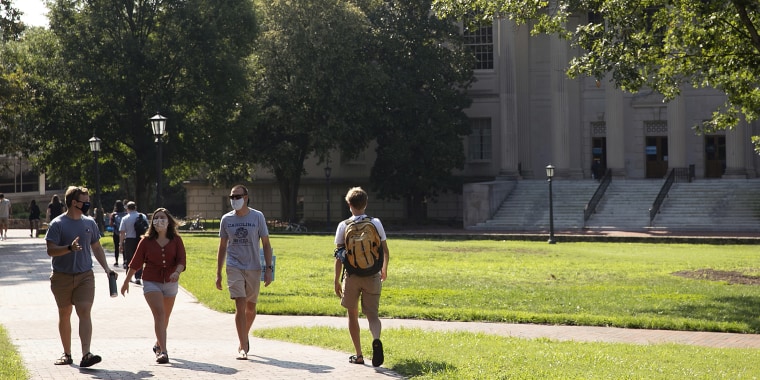Many students heading to college for the fall semester are getting an unwanted and up-close education about the spread of the new coronavirus.
The University of North Carolina at Chapel Hill announced Monday it was converting to all virtual classes after reporting 135 new COVID-19 cases within a week of starting in-person classes.
The University of Notre Dame suspended in-person classes a day later after 146 students and a staff member tested positive for the coronavirus.
Cases have also been reported in Greek life housing at Auburn University in Alabama and North Carolina State University. Oklahoma State University began its semester with an entire sorority under quarantine.
Experts were not surprised.
"Universities represent highly dynamic communities with thousands of young people — from around the country and the world — living and learning in close quarters," Dr. Howard Koh, a Harvard University professor and a former assistant secretary for health at the U.S. Department of Health and Human Services, told NBC News.
"These clusters in the opening days of reopening make any sustained in-person learning much less likely for the upcoming fall."
But while people may think colleges aren’t taking enough precautions, it’s actually what happens off campus that seems to be the greatest factor in the spread, said Dr. Marissa Levine, director of the Center for Leadership in Public Health Practice at the University of South Florida in Tampa.
“You can re-engineer facilities and buildings, change policies and educate folks — and things might work very well if people just stayed on campus,” Levine told TODAY.
“But if those same students go off campus and there are no safeguards in place and their behaviors change as a result, then it almost doesn’t matter what you do on campus.”
Recent videos have been shared showing huge parties with crowds of young people practicing no social distancing or wearing masks, including a massive gathering at an apartment complex near the University of North Georgia.
In parts of the country where community transmission is still high — which also means the likelihood of students coming to school with COVID-19 is high — what happens off campus is going to affect the classroom, even if the college puts together an incredibly robust plan, Levine said.
“You’re talking about young people who generally feel invincible and many of them may have not paid much attention to COVID. For a lot of them, particularly freshmen, it’s their first time away from home and they’re exploring,” she added.
Several University of Connecticut students were evicted from their residence halls on Wednesday after a video showed undergrads at a packed dorm room party where almost nobody was wearing a mask and there was zero social distancing.
But just because it’s a dorm — or a classroom, cafeteria or library — doesn’t necessarily mean there will be significant coronavirus transmission, Levine said.
The shared spaces can be made safer with the basics — people wearing masks and social distancing — and precautions like separating desks, limiting the number of people in the room and changing the HVAC systems to bring in more outside air and circulating it more frequently to dilute any virus that might be in there.
“It’s very possible that you could go into those spaces and not worry too much,” she said. “But at the end of the day, it’s all about human behavior.”
Before heading to college, Levine advised students and their parents to consider:
- Your own risk assessment. Are there any health issues that could put you or your family members at risk for complications or death from COVID-19? For example, a student who lives in a multi-generational household could be putting elderly loved ones at risk when coming back home from college.
- What’s being done at the university to protect the health of students. What is the mask requirement? What are the hygienic practices?
- What the college is going to do if there’s a case. How are officials doing testing to know what is happening on the campus in real-time? Have they worked with their local health department? Has it blessed their plan?
Purely from a public health point of view, it would be best to do as much virtual learning as possible until there's a treatment or vaccine, but in reality, that may not result in equitable educational opportunities for everyone, Levine said.
“We’re exploring in an experiment, if you will, of whether this can be done safely and it’s not clear yet whether that’s true,” she noted.
“In some ways, it’s harder to open up and close down again so being patient and waiting might be good.”


